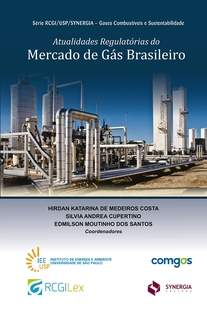Atualidades Regulatórias do Mercado de Gás Brasileiro
HIRDAN KATARINA DE MEDEIROS COSTA • SILVIA ANDREA CUPERTINO • EDMILSON MOUTINHO DOS SANTOS
CoordenadoresCátedra do Gás, projeto de pesquisa e desenvolvimento do Instituto de Energia e Ambiente (IEE) da USP
 Comprar O ano de 2017 é sem sombra de dúvidas memorável. A Lei do Petróleo completa 20 anos de promulgação e junto traz importante reflexão sobre o papel da Petrobras no setor de petróleo e gás diante do seu plano de desinvestimento. A Lei do Gás faz oito anos e, paralelamente, o Governo Federal leva adiante a iniciativa 'Gás para Crescer' com a participação dos diversos agentes do setor. Podemos assistir, portanto, à uma ebulição de possíveis propostas de alteração de tais normas diante das contribuições e das discussões ora correntes. Ao longo do livro foi possível verificar as mudanças ocorridas na indústria nacional do gás desde a edição da Lei do Petróleo, ocorrida em 1997, passando também pela promulgação da Lei do Gás, em 2009.
Comprar O ano de 2017 é sem sombra de dúvidas memorável. A Lei do Petróleo completa 20 anos de promulgação e junto traz importante reflexão sobre o papel da Petrobras no setor de petróleo e gás diante do seu plano de desinvestimento. A Lei do Gás faz oito anos e, paralelamente, o Governo Federal leva adiante a iniciativa 'Gás para Crescer' com a participação dos diversos agentes do setor. Podemos assistir, portanto, à uma ebulição de possíveis propostas de alteração de tais normas diante das contribuições e das discussões ora correntes. Ao longo do livro foi possível verificar as mudanças ocorridas na indústria nacional do gás desde a edição da Lei do Petróleo, ocorrida em 1997, passando também pela promulgação da Lei do Gás, em 2009.
Igualmente, desde então o mercado do gás no Brasil tomou proporções relevantes em virtude da crescente demanda dos últimos anos, não obstante estarmos ainda longe do desejável em termos de uso abrangente de gás, e a preços competitivos.
Ademais, a expectativa de produção do Pré-sal, apesar de ainda não se ter dados precisos, pode elevar a oferta desse energético, que tem sido apontado como combustível de transição para um mundo com predominância das fontes renováveis de energia.
Dessa forma, este livro, como uma obra coletiva, apresenta análises atinentes ao mercado do gás natural no Brasil em suas diversas etapas. Ele foi desenvolvido por pesquisadores do Instituto de Energia e Ambiente da Universidade de São Paulo (IEE/USP) e do Fapesp Shell Research Center for Gas Innovation (RCGI), com sede na USP. Resultado de uma parceria entre a Fundação de Amparo à Pesquisa do Estado de São Paulo (FAPESP) e a Shell, o RCGI fomenta a pesquisa científica de alto nível para o desenvolvimento do setor de energia.
Cada capítulo foi cuidadosamente pensado pelos seus autores no sentido de proporcionar aos leitores uma visão geral do problema abordado, com objetivos claramente delineados e atualidades regulatórias especialmente baseadas dentro da iniciativa 'Gás para Crescer'. O pioneirismo dessa obra com certeza traz ao público a possibilidade de ter acesso didático ao tema, que é objeto de debates desde meados de 2016 e que continuará na pauta do setor nos meses que se seguem, haja vista o Ministério de Minas e Energia ter anunciado possível minuta de projeto de lei a ser enviado ao Poder Executivo e, consequentemente, ao Poder Legislativo.
Ademais, os capítulos abordaram de forma didática as diversas normas editadas pela Agência Nacional de Petróleo, Gás Natural e Biocombustíveis (ANP) e demais órgãos governamentais competentes.
A estrutura capitular do livro pretendeu percorrer historicamente a cadeia de valor do gás, não olvidando os aspectos técnicos, regulatórios e econômicos peculiares à indústria de redes.
O capítulo primeiro ateve-se aos principais aspectos constitucionais afetos ao tema. O capítulo segundo apresentou a evolução legislativa e detalhou o contexto da iniciativa 'Gás para Crescer'. O capítulo terceiro trouxe a relevância do entendimento do compartilhamento da infraestrutura, como às relativas ao processamento do gás, para a ampliação da concorrência no setor. O capítulo quarto adentrou temas pertinentes ao transporte de gás, e o quinto explorou tanto os tributos, quanto as participações governamentais.
Os capítulos seis e sete abordaram questões da ótica ambiental e do gás não convencional. Já os últimos capítulos concentram-se em desafios com perspectivas de casos concretos. Nessa linha, o capítulo oitavo analisou o mercado livre do caso e sua regulamentação no Estados brasileiros e dentro da legislação federal.
Os capítulos nove e dez contaram com a participação de autores provenientes do Instituto de Economia da Universidade Federal do Rio de Janeiro, demonstrando a riqueza de interação entre universidades e grupos de pesquisa. E, o capítulo onze finaliza comparando o histórico regulatório da indústria de gás dos Estados Unidos e do Brasil.
O livro, portanto, é uma importante contribuição científica para o setor de gás, servindo como obra basilar para o futuro que segue, posto que as discussões da iniciativa 'Gás para Crescer' transcorrerão certamente para esferas do processo legislativo com propositura de importantes modificações normativas.
Assim, as contribuições imparciais da academia na reflexão sobre o tema trazem o enriquecimento de conteúdo informativo e analítico para a continuidade do debate e para o enfrentamento de questões que ainda são entraves ao amplo desenvolvimento do mercado de gás no Brasil. O presente livro, portanto, mais do que inédito, é atual, e serve como embasamento para as reflexões que se seguirão no Brasil ao longo do tempo.
